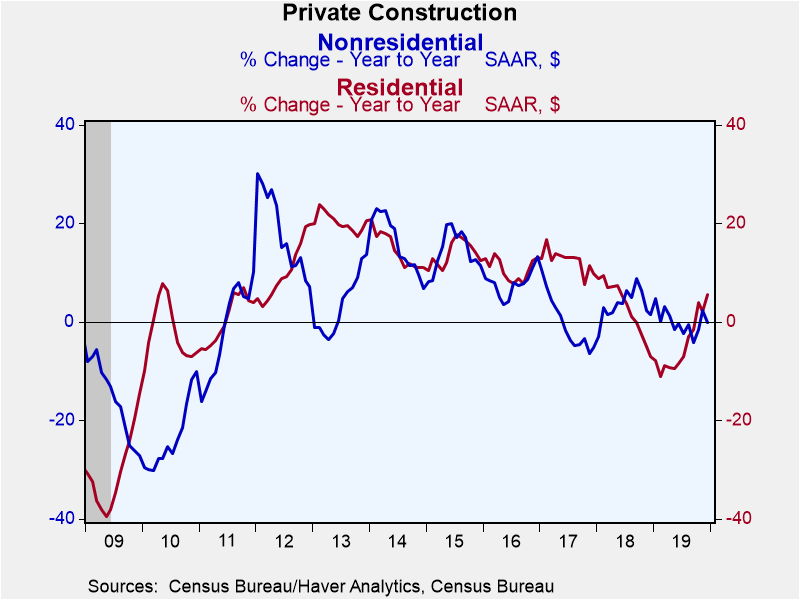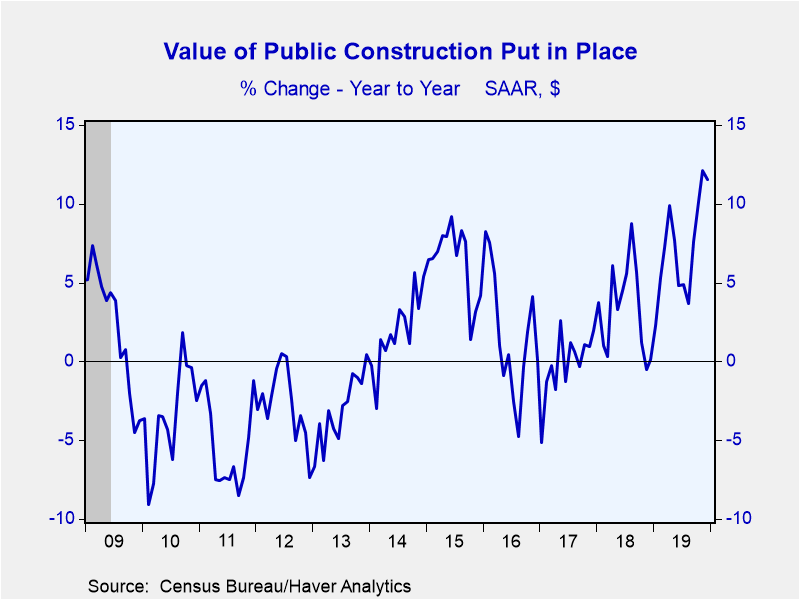 Global| Feb 03 2020
Global| Feb 03 2020U.S. Construction Spending Declines Unexpectedly; Upward Revisions Softens Blow
Summary
• Construction spending decreased 0.2% in December. • Upward revisions to previous months suggest little impact on Q4 GDP. • Strong residential construction was offset by weak non-residential, consistent with the Q4 GDP data. The [...]
• Construction spending decreased 0.2% in December.
• Upward revisions to previous months suggest little impact on Q4 GDP.
• Strong residential construction was offset by weak non-residential, consistent with the Q4 GDP data.
The value of construction put-in-place declined 0.2% in December (+5.0% year-on-year). November was revised up to a 0.7% gain (was 0.6%), while October was recast to 0.4% from 0.1%. The Action Economics Forecast Survey had expected a 0.4% rise in December. This data is unlikely to have a meaningful impact on the construction spending portion of fourth quarter GDP. In the fourth quarter GDP report released last week, private construction spending (nonresidential + residential) subtracted 0.1 percentage point from GDP growth.
Private construction edged down 0.1% (+2.9% y/y) in December while public contracted 0.4% (+11.5% y/y).
Residential construction increased 1.4% (5.5% y/y) with the 2.7% gain in single family (5.2% y/y), more than offsetting the 1.8% decline in multifamily (-7.1% y/y). Nonresidential construction fell 1.8% (-0.1% y/y) with the four largest sectors – power, commercial, manufacturing, and office all down in December.
Nonresidential public construction, which makes up 98% of public construction, declined 0.4% in December (+11.2% y/y), with decreases in school spending and gains in road building.
The construction spending figures, some of which date back to 1946, are in Haver's USECON database. The expectations reading can be found in the AS1REPNA database.
| Construction Put in Place (SA, %) | Dec | Nov | Oct | Dec Y/Y | 2018 | 2017 | 2016 |
|---|---|---|---|---|---|---|---|
| Total | -0.2 | 0.7 | 0.4 | 5.0 | -0.3 | 3.3 | 4.5 |
| Private | -0.1 | 0.6 | 0.6 | 2.9 | -2.5 | 3.2 | 6.0 |
| Residential | 1.4 | 1.5 | 0.5 | 5.5 | -4.7 | 2.8 | 12.4 |
| Nonresidential | -1.8 | -0.5 | 0.8 | -0.1 | 0.0 | 3.7 | -0.7 |
| Public | -0.4 | 1.0 | -0.2 | 11.5 | 7.1 | 3.6 | -0.1 |
Gerald D. Cohen
AuthorMore in Author Profile »Gerald Cohen provides strategic vision and leadership of the translational economic research and policy initiatives at the Kenan Institute of Private Enterprise.
He has worked in both the public and private sectors focusing on the intersection between financial markets and economic fundamentals. He was a Senior Economist at Haver Analytics from January 2019 to February 2021. During the Obama Administration Gerald was Deputy Assistant Secretary for Macroeconomic Analysis at the U.S. Department of Treasury where he helped formulate and evaluate the impact of policy proposals on the U.S. economy. Prior to Treasury, he co-managed a global macro fund at Ziff Brothers Investments.
Gerald holds a bachelor’s of science from the Massachusetts Institute of Technology and a Ph.D. in Economics from Harvard University and is a contributing author to 30-Second Money as well as a co-author of Political Cycles and the Macroeconomy.









